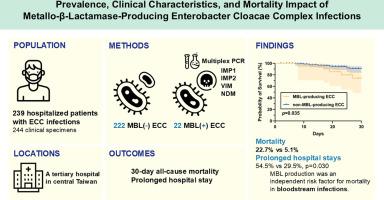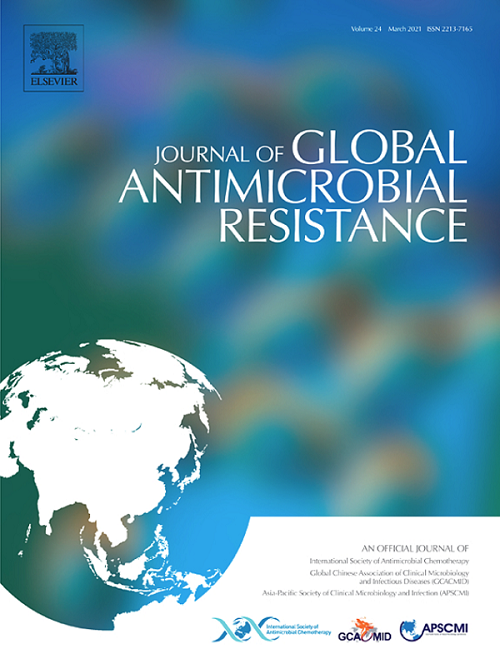Prevalence, Clinical Characteristics, and Mortality Impact of Metallo-β-Lactamase-Producing Enterobacter Cloacae Complex Infections: A Retrospective Cohort Study
IF 3.2
3区 医学
Q2 INFECTIOUS DISEASES
引用次数: 0
Abstract
Objectives
Metallo-β-lactamase (MBL)-producing Enterobacter cloacae complex (ECC) is an emerging threat associated with limited treatment options and increased mortality. This study aimed to describe the clinical and molecular characteristics, risk factors, and outcomes of MBL-producing ECC infections in Taiwan.
Methods
We conducted a retrospective cohort study at a tertiary hospital in central Taiwan from July 2022 to December 2023. Hospitalised patients with ECC infections were included. MBL production was determined using multiplex PCR for blaIMP-1, blaIMP-2, blaVIM, and blaNDM genes. We compared clinical characteristics, antibiotic susceptibility profiles, and outcomes between MBL-producing and non-MBL-producing ECC infections.
Results
Among 239 patients with ECC infections, 9.2% (22/239) were MBL-producing. blaNDM was the predominant MBL gene (72.7%, 16/22). MBL-producing ECC showed significantly lower antibiotic susceptibility compared to non-MBL-producing ECC, except for amikacin and tigecycline. Patients with MBL-producing ECC infections had higher rates of ICU admission (50.0% vs. 11.1%, p < 0.001), prolonged hospitalisation exceeding four weeks (54.5% vs. 29.5%, p = 0.030), and 30-day all-cause mortality (22.7% vs. 5.1%, adjusted HR: 2.95, 95% CI: 1.02–8.52, p = 0.035). MBL production was an independent risk factor for mortality in bloodstream infections.
Conclusions
MBL-producing ECC infections are associated with high antibiotic resistance, increased healthcare resource utilisation, and significantly higher mortality, particularly in bloodstream infections. The predominance of blaNDM among MBL genes aligns with recent regional trends. These findings underscore the urgent need for enhanced surveillance, rapid diagnostics, and targeted management strategies to address this emerging threat.

产生金属β-内酰胺酶的阴沟肠杆菌复合感染的患病率、临床特征和死亡率影响:一项回顾性队列研究。
背景:产生金属β-内酰胺酶(MBL)的阴沟肠杆菌复群(ECC)是一种新出现的威胁,与有限的治疗选择和死亡率增加有关。本研究旨在探讨台湾地区产生mbl的ECC感染的临床及分子特征、危险因素及转归。方法:于2022年7月至2023年12月在台湾中部某三级医院进行回顾性队列研究。纳入ECC感染的住院患者。采用多重PCR检测blaIMP-1、blaIMP-2、blaVIM和blaNDM基因的MBL产量。我们比较了产生mbl和非产生mbl的ECC感染的临床特征、抗生素敏感性和结果。结果:239例ECC感染患者中,9.2%(22/239)产生mbl。blaNDM为显性MBL基因(72.7%,16/22)。除了阿米卡星和替加环素外,产生mbl的ECC对抗生素的敏感性明显低于非产生mbl的ECC。产生mbl的ECC感染患者的ICU入院率更高(50.0% vs 11.1%)。结论:产生mbl的ECC感染与抗生素耐药性高、医疗资源利用率增加和死亡率显著升高有关,特别是在血液感染中。blaNDM在MBL基因中的优势与最近的区域趋势一致。这些发现强调迫切需要加强监测、快速诊断和有针对性的管理战略,以应对这一新出现的威胁。
本文章由计算机程序翻译,如有差异,请以英文原文为准。
求助全文
约1分钟内获得全文
求助全文
来源期刊

Journal of global antimicrobial resistance
INFECTIOUS DISEASES-PHARMACOLOGY & PHARMACY
CiteScore
8.70
自引率
2.20%
发文量
285
审稿时长
34 weeks
期刊介绍:
The Journal of Global Antimicrobial Resistance (JGAR) is a quarterly online journal run by an international Editorial Board that focuses on the global spread of antibiotic-resistant microbes.
JGAR is a dedicated journal for all professionals working in research, health care, the environment and animal infection control, aiming to track the resistance threat worldwide and provides a single voice devoted to antimicrobial resistance (AMR).
Featuring peer-reviewed and up to date research articles, reviews, short notes and hot topics JGAR covers the key topics related to antibacterial, antiviral, antifungal and antiparasitic resistance.
 求助内容:
求助内容: 应助结果提醒方式:
应助结果提醒方式:


